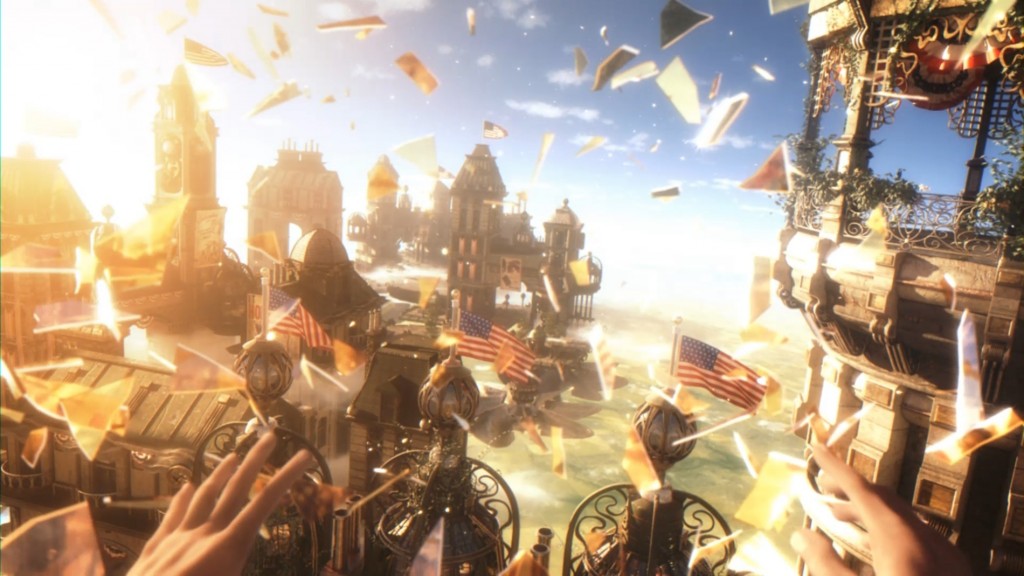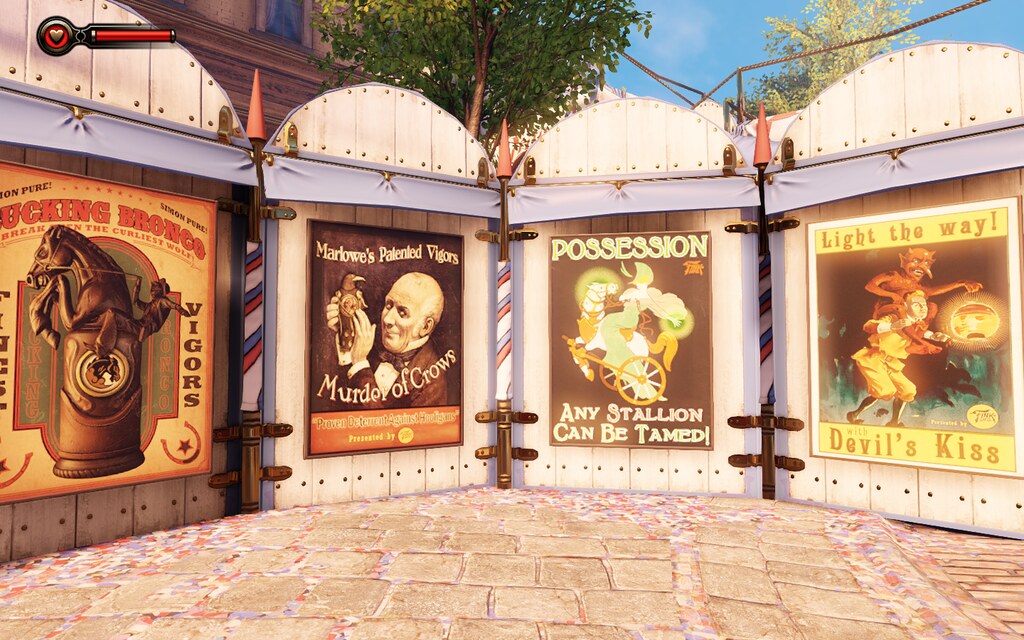Culture
Bit Slap: “Bioshock Infinite”

Every Thursday in Bit Slap, Joe Anderson and Chuck Rios bring you the latest in gaming news and bon mots. This week, Chuck reviews the PC version of Bioshock Infinite.
Bioshock Infinite is the latest creation from game developer Ken Levine and Irrational Games, the creators of the original Bioshock, released nearly ten years ago. Like its predecessor, Bioshock Infinite oozes with a unique aesthetic, extreme attention to detail, and superb world-building not found elsewhere in gaming. It’s an incredible swan-song for the current generation of gaming as the industry transitions to bigger, better things.
Infinite takes place in the floating city of Columbia during 1912, suspended above the rest of the world. Despite Columbia’s constant motion and changing landscape, the city runs like clockwork: the buildings have schedules and docking procedures for citizens of Columbia. The player also travels between floating islands via skyhook, essentially a claw that attaches to suspended rails throughout the city. When you traverse Columbia using them, they give a sense of freedom and speed, but most importantly of maneuverability of approach to combat. They feel like an integral part of the city and best of all, like a virtual roller coaster.
Columbia is touted by its citizens as a land of unparalleled opportunity and is governed by founder and religious figure Father Zachary Comstock, often referred to as “The Prophet.” Almost immediately upon entering the city, the players are pounded over the head with proclamations of Comstock’s greatness. Father Comstock is revered as a god and his story—along with the creation of Columbia—are treated like a religion. America’s founding fathers are worshipped much the same way; Father Washington, Father Franklin, and Father Jefferson are similar pinnacles of worship for the people of Columbia and each are associated the symbols of the sword (power), key (wisdom), and scroll (education and freedom). The worshipping of these iconic American figures is especially interesting since Columbia ceded from the Union at the turn of the century.

Players assume the role of Booker Dewitt, a Pinkerton agent seeking to absolve himself of a gambling debt. In order to do so, he must find and bring Elizabeth, a young woman locked in a tower, back to the United States. Elizabeth is intertwined in the city’s religious narrative and is referred to as a miracle child and “The Lamb” by the people of Columbia. Elizabeth has the power to open tears, rips in time and space that lead to alternative timelines. This power, coupled with her lifetime in captivity, surrounds Elizabeth in a layer of intrigue for the player to cut through. To further complicate the player’s mission, Comstock has foretold Booker’s plan to rescue Elizabeth from the tower and labels him as an antichrist figure.
Infinite contains a deeply detailed world, rife with minute details that brings the game’s setting to life. The floating buildings in the distance are simply amazing and the first time you look for a vista and see the buildings actually float and fly in the distance, to and from their scheduled destinations, it’s simply breathtaking. The game does a great job of capturing the aesthetic of the WWI-era style for both characters and architecture: Columbia is aggressively industrial, but at the same time very old-fashioned and prim.
The scenery is varied and helps instill a sense of unease that really gets you questioning everything around you. Infinite especially excels at maintaining its use of open and closed spaces. As a city in the clouds, Columbia is a very open space, and there is a sense of freedom that Levine stated was a challenge to maintain the horror elements of the game with the sense of open freedom the city presents. As Booker delves more into the deeper parts of the city, the seemingly perfect lives of its citizens become twisted and leave players questioning what lies in the hearts and values of Columbia and its denizens.
Infinite’s gameplay is mechanically solid throughout. Players can consume a variety of tonics that grant superhuman powers—not the least of which involves commanding flesh-eating crows with your hands that nest in people when they die, then becoming crow landmines that spread even more flesh-eating crows. The game also offers a good variety of guns, most of which are the standard fare of rifles, pistols, and shotguns found in most shooters. There are upgrades for tonics and weapons alike, which can be bought using the money scattered throughout the game. There’s also an equipment system that gives the player passive abilities to accommodate various play styles to upgrade Booker with, like a hat that lets ignite enemies with melee attacks or pants that turns the guns of fallen enemies into ghosts that fight for you. You’ll need the best upgrades and gear to tackle the game’s hardest difficulty: “1999 Mode.”

The sound design of Infinite is also superb. Tonics, guns, allies and enemies have great diversity to them, and always let me know when a Robo-Washington is coming to chop my cherry tree. Series composer Gary Schyman returns to score the game and defines the world and characters through his soundscapes. Perhaps more interesting than Schyman’s score, however, is Infinite’s use of licensed music. I was impressed when Tears for Fears’ “Everybody Wants to Rule the World” and Cyndi Lauper’s “Girls Just Want to Have Fun” came piping through one of Elizabeth’s tears in space-time.
The propaganda, music, and architecture throughout the game convey the culture and story of Columbia without taking away player agency. This approach to world-building allows for greater exploration and lets the player develop their own understanding of Columbia, especially when it comes to the communicating the racial hierarchy of the city. Columbia is filled with voxphones (voice diaries of people who live there), “Protect Our Race” posters, a museum celebrating Columbian hero John Wilkes Booth, and racially charged depictions of Asians, African-Americans and the Irish. It’s an odd city, and one that drives your curiosity the entire way through to discover its secrets.

When players finish the game and get a chance to wrap their head around the story and scope of the game, they’ll see that Bioshock Infinite is an incredible game. It’s an experience filled with amazement and wonder, and ultimately you’ll find yourself wanting to go back to Columbia just to see all the nuances and attention to detail this game has. Bioshock Infinite is one of the best games of 2013 so far, and an incredible experience that you shouldn’t miss.